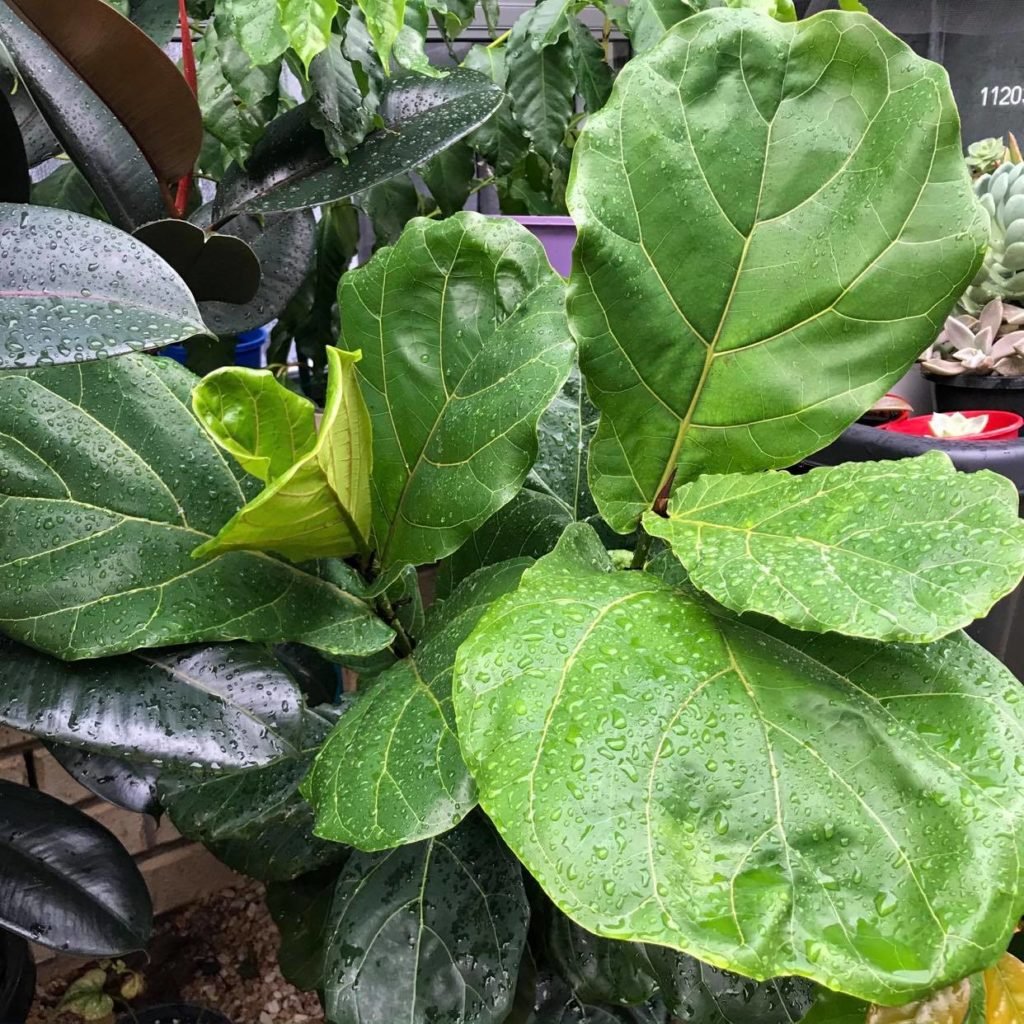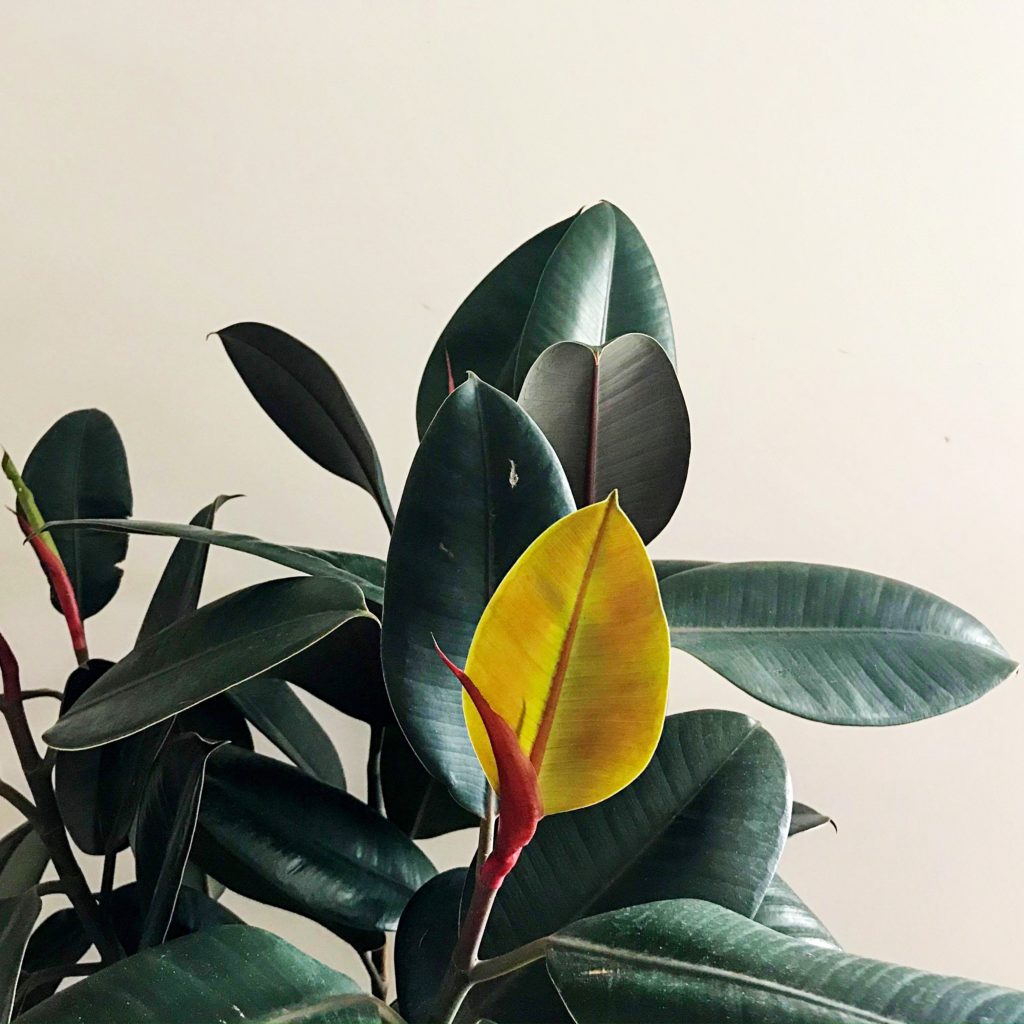Ficus lyrata a.k.a Fiddle Leaf Fig

Fiddle Leaf Fig Quick Overview
| Full Size | 90cm to 1.5 metres indoors 12-15 meters outdoors |
| Light | Bright filtered light |
| Temperature | 60 to 95°F (15 to 30˚C) |
| Humidity | 30-65% |
| Cost | $ |
| Care Level | Medium |
| Toxicity | Toxic |
Ficus lyrata most commonly referred to as Fiddle Leaf Fig are a species of large flowering plants native to Western Africa. Ever increasing in popularity as an indoor plant, these can now be found world wide making statements as living decor.
Boasting beautiful deep green foliage, with clearly defined veins strung throughout the Ficus lyrata is a must have for any indoor plant collection. It’s tree like shape and size adds a great height element which contrasts nicely with other indoor plant varieties.
Fiddle Leaf Fig Size
When kept indoors within a pot, you can expect your plant to reach 3-5 foot (90 cm to 1.5 metres) in height. Leaves on a mature fiddle leaf fig will typically reach 10 Inches in length and 5 inches in width (25cm L x 12cm W).
Outdoors planted directly into the ground, Fiddle leaf figs can grow up to 40-50 foot (12 to 15 metres). The large height is credited to the plants roots able to spread further. This allows the plant to capture more nutrients and water, which is vital to growth.
You can control the height of your fiddle leaf fig when kept in pots by re potting your plant into the same size pot. Make sure when you do this to provide new soil to allow the plant to have access to new nutrients. Gently removing 5-15% of foliage and roots whilst re potting will assist in size control.
Light Requirements
Fiddle Leaf Figs prefer to be positioned in bright filtered light, as this is similar to that of the conditions they are grown in at nurseries and garden centers. However; due to being native to the hot sunny environment of Western Africa, Fiddle Leaf Fig can be conditioned to live in full sun for around 8 hours per day.
The process of light conditioning is called hardening. This can be done successfully by gradually introducing your plant to more and more light, whilst increasing duration of sun exposure. Be sure to slowly acclimate your plant to avoid sun damage. Signs of sun damage include burnt or dried out foliage.
A sign your fiddle leaf fig is not getting enough light is yellow leaves, brown spot and leaf drop. Low light problems are easily resolved by changing the position of your plant to somewhere that better suits its light requirements.
Temperature
Fiddle Leaf Figs will grow best when in an area which maintains a temperature of 60 to 95°F (15 to 35˚C). Being kept outside of this temperate range for prolonged periods of time can lead to poor plant health. If the temperatures drop below 50ºF (10ºC), it can develop brown spots. During the cooler months, you should move your Fiddle Leaf Fig to a warmer spot in your home.
Humidity
Fiddle Leaf Fig will thrive when kept in an average to slightly above average humidity (between approximately 30 and 65%). This will help assist in keeping your Fiddle Leaf Fig happy and healthy. Providing a high humidity for your plants will encourage bigger and healthier growth. There are a few thing you can do that can help bump up the humidity in your home. The things you can try are:
- Misting your plants
- Pebble trays
- Grouping plants together
- Humidifier
You can read more about increasing humidity in your home here.
Watering Requirements
You can expect your Fiddle Leaf Fig to require water once a week during the growing period. Before watering, you should check the top few inch of soil to feel if it is dry. If the soil is dry, it’s time to give your plant a drink. When watering your Fiddle Leaf Fig, be sure to water thoroughly until water is draining into the saucer. Aside from solely relying on the watering frequency to tell when your plant is thirsty, a tell tale sign that your Fiddle Leaf Fig needs water is when the leaves are starting to look floppy.
When watering your Fiddle Leaf Fig, you need to be cautious of over-watering. Excess water to the soil can cause it to become waterlogged and cause the roots to start rotting. Rotted roots can no longer absorb any nutrients or water for the plant. This can cause fungus issues, pest problems and root-rot. A sign that you may have over-watered your Fiddle Leaf Fig is brown and dropping leaves.
Fertilizing requirements
You should fertilise your Fiddle Leaf Fig monthly during Spring and Summer. You can cut back on fertilising during the cooler months when the plant isn’t actively growing. Applying fertiliser when your plants aren’t actively using all the nutrients in the soil can cause salt build up and root burn. Fertilising your plants will give them the essential nutrients they need for promoting and maintaining new and healthy growth.
The best fertiliser to use for Fiddle Leaf Fig would be 3-1-2 NPK fertiliser. Depending on what you prefer, you can either use a liquid fertiliser or a slow release fertiliser. This will assist in keeping your plant happy as well as promote new and healthy growth. Signs that your Fiddle Leaf Fig might need fertilising is stunted growth, small leaves and/or discoloured leaves.
Another thing you need to be cautious of when fertilising your houseplants is over-fertilising. A sign that you’ve over-fertilised your Fiddle Leaf Fig is the plant becoming leggy. Over-fertilising can cause chemical burn and can lead to plant death. If you think you’ve over-fertilised your plant, you can change the soil or rinse the fertiliser out. The water colour will change once the fertiliser has been rinsed out.
For more information on fertilising houseplants click here.
Soil Requirements
Fiddle Leaf Figs require a well aerated, fast draining soil. They prefer a relatively dry soil that keeps the roots moist but not wet. You can use orchid bark, perlite, peat and charcoal mixed together to create drainage and aeration. Poor soil can cause fungus and bacterial problems in your plants root system, as well as cause problems with root aeration. Air flow is important as it allows the plants roots to breath. Not having enough oxygen to the roots can cause them to start rotting.
As for re-potting, the warmer seasons (spring and summer) are the best time to change pots. Depending on your plants age and growth will determine how often it should change pots. Young, fast growing plants should be re-potted every 8-12 months, whereas more mature plants should need re-potted every 1-2 years. When re-potting, choose a pot that is only slightly larger than the current one to avoid drowning your plants roots. Typically pots 2-4 inches (5-10cm) are the way to go.
Re-potting is an excellent time to check the health of your Fiddle Leaf Figs roots, which are otherwise unseen. Make sure to go over and visually check for bacteria or fungal growth. If you notice signs of infection such as root rot, take the appropriate steps for treatment & prevention immediately. For more information on root rot check out our identification and treatment article.
Diseases & Pests
The most common pests that you can encounter on your Fiddle Leaf Fig are Mealybugs, Scale, Spider Mites, Whiteflies and Aphids. The most common diseases your may encounter are Edema, Root-rot, Bacterial infections and Powdery Mildew. For more information on common Fiddle Leaf Fig pests and diseases click here. For can find other common Fiddle Leaf Fig issues and how to fix them here.
The best thing you can do when it comes to pests on houseplants is to try and avoid any pest infestations from starting. There are a few things you can do that will assist in preventing any pest infestations and these things are:
- Checking new plants for pests or isolating new plants for up to a week.
- Check your plants every few days for pests.
- Trim off any dead or dying leaves.
- Wipe down leaves if you notice them getting dusty.
- Keeping your plants healthy. A healthy plant will be able to handle an infestation better than those that aren’t as happy.
- Isolate any plants that have pests.
Following this will assist in keeping pests away as well as catch them early on before any severe infestations are able to start. Keeping plants healthy and in the correct living environments can help to deter any pests from invading your plants. For more information on common houseplant pests click here.
Toxicity
Fiddle Leaf Figs are considered to be toxic. The leaves of a fiddle leaf fig contain toxic calcium oxalate. For an adult, a bite out of a leaf won’t kill you but if ingested by children or animals, it can be slightly more dangerous. If accidentally ingested and any symptoms occur make sure to seek the appropriate medial attention immediately.
Pets, such as cats and dogs, are susceptible to Ficus Lyrata poisoning especially if they are young and teething. The most common signs of ingestion in pets is vomiting, excessive drooling and signs of distress. In rare cases swelling of air ways may occur and cause breathing difficulties.



